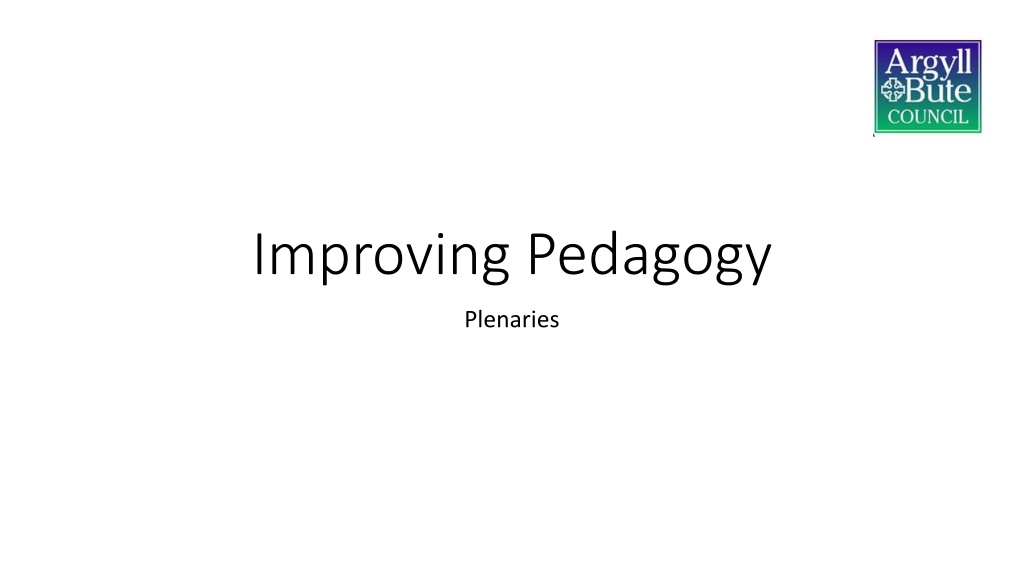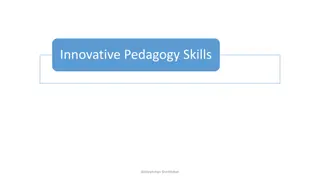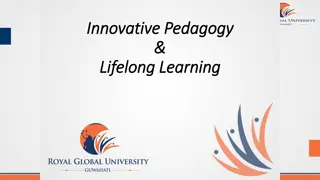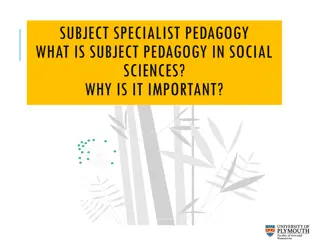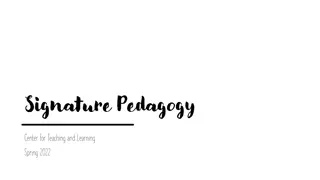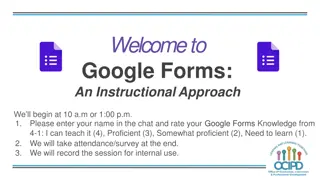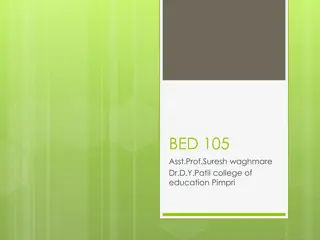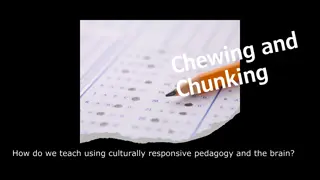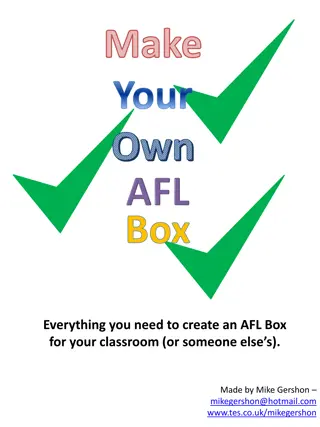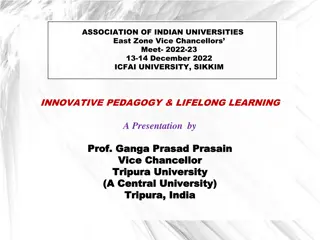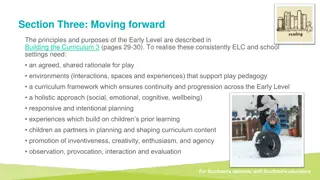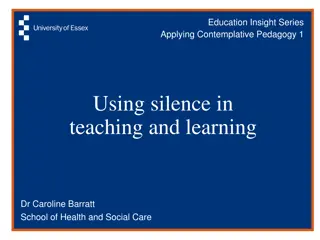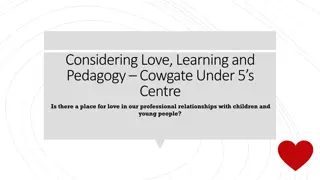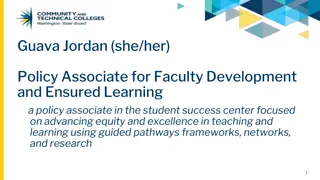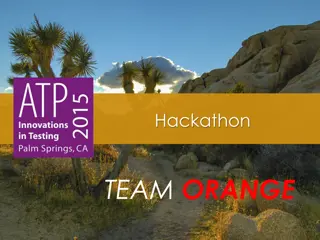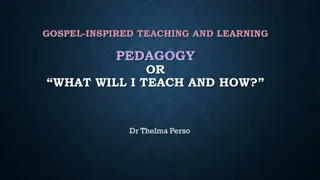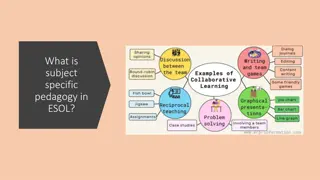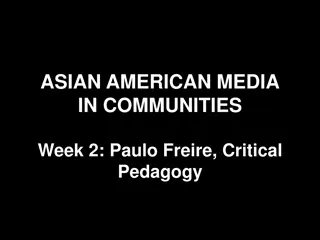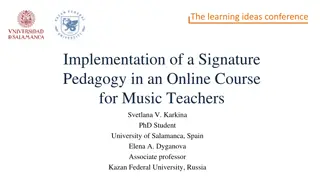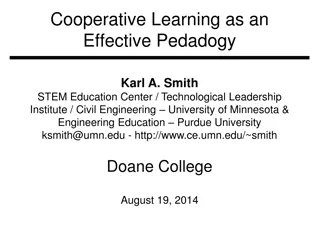Enhancing Learning Through Effective Pedagogy in Plenaries
Explore the significance of pedagogy in plenaries to reinforce learning, make connections, and facilitate smooth transitions. Understand the principles, challenges, and practices to optimize student engagement and learning outcomes.
Uploaded on Oct 09, 2024 | 0 Views
Download Presentation

Please find below an Image/Link to download the presentation.
The content on the website is provided AS IS for your information and personal use only. It may not be sold, licensed, or shared on other websites without obtaining consent from the author. Download presentation by click this link. If you encounter any issues during the download, it is possible that the publisher has removed the file from their server.
E N D
Presentation Transcript
Improving Pedagogy Plenaries
Purpose To re-visit and embed the relevance of learning To make links between what has been covered in this lesson and other contexts To bring back to the fore previous learning that is connected to current focus To see the bigger picture (e.g. where you used to be, where you are now and where you will be next) To enable pupils to develop a sense of self-concept about the focus To help bring about a neat transition to the next part of the school day
What they are not so good at Learning is as fresh as it s going to be so plenaries in the same lesson can t show deep or embedded learning, only mimicry They should not usually show the teacher which pupils are having problems this information should come through the teaching phase of the lesson and through teacher observation during the lesson
Principles Whole class engagement (do you have year plenaries or whole class?) Effective use of questions and comments Planned purposeful plenaries (at the start of the lesson remind yourself what the purpose of the plenary will be) Plenaries should reflect some of the key points that arise during the lesson (misconceptions, common errors, different ways of finding the solution Pupils used as agents of each others learning
Problems Multi-level composite classes where groups are working on different Es and Os The mask of mimicry (sure I can recite the four times table now while it is fresh, but can I do it next week?) Learning is one dimensional (I can say the four times table, but can I relate it to other tables, can I solve problems using 4 x table facts, can I use the facts to work out the first 5 facts of the 8 times table, can I apply it to musical notation, replication of patterns in nature?) Plenaries only engage some learners Surface level reflection only how did you feel about it, how did you do
Practice Separate plenaries for each level (e.g. P1 set to a play task while P2/3 engage in plenary) Effective use of comments / questions Think / Pair / Share or other whole class engagement Pupils lead where possible Every lesson has a plenary Focus on connections to previous learning and to future learning (progression) (think tube map) to other learning in the subject to other subjects to real life applications
Examples: P1 (while P2/3 complete independent or group tasks) At the end of a lesson on phonics which has focused on th . At the start there was teacher led input followed by pupils making th with materials and finding words with initial phoneme. Pupils then had some time to play while the teacher worked with P2/3. Plenary bring the children back together again. Remind them of th using comments repeating the th often. Ask questions what kind of words have th ? Where have we seen th before? Do you know what sound we make if we remove the h ? What words start with t ? What other sounds do we know that have two letters? Everyone chose their favourite th word and tell their partner. Next time we will be looking at ch this says ch. Can anyone think of a ch word? Your challenge today and tonight is to spot ch words and we will look at this tomorrow.
P4 At the end of a reading lesson on scanning for information. At the start there was a warm up with children doing a word search puzzle. Teacher then drew the comparison with scanning a bigger text for key words. Pupils were then set off to scan for words in a text. Plenary bring children together while P5-7 complete independent or group tasks. Remind pupils of the LI and SC. What words were easier for you to scan? What techniques did you use? Did anyone look for the first letter only? Did anyone look for the shape of the whole word? Which was easier? We can use scanning to find more information in a text than a single word. Look at this passage from BFG . What does Roald Dahl call the Witching Hour? How can we use scanning to quickly find just that answer? Where else might scanning be useful? Let s look at Bloom s. What kind of questions can be quickly answered by scanning? What kind of questions will need a more thorough reading?
P1-2 whole class In a lesson about describing characters that started with a reading from Charlie and the Chocolate Factory. P3 were set off to match adjectives to characters and add adjectives of their own, P2 worked with CA to match adjectives to characters and teacher worked with P1s to reinforce some basic character adjectives using pictures from the book. Plenary bring all class together and pair them (each P1 has a P2 or 3 partner). Close your eyes everyone and think of a character from CACF. Imagine you are looking at a picture of that person. I want you to think of three words to describe them. When your partner tells you their words, your job is going to be to listen so carefully that you can repeat what they say. Think-Pair-Share. Next time, we are going to be making characters of our own. They can be nice, nasty, tall, short, rotund or slightly built. Pick one or two of the words from the word wall (P3, don t forget to include some red words) to describe a character and close your eyes and imagine you are looking at a picture of the character. Think-Pair-Share again.
P4-7 whole class After a lesson on time where P4 focussed on telling the time on analogue and digital clocks (1/4 to and past and in increments of 5 minutes). P5 and 6 have been working out durations by counting on and back using clocks and P7 have been using s= d/t to solve problems. Plenary Establish pairs from the same groups and give each 10 minutes to prepare a summary of what they have been doing. They should tell another group what they have been doing and how they solved the problems they had. (groups will have different prompts including what was most difficult thing you learned to do? What was so difficult, you are still not sure of? What was easy about what you did). Now put pairs together. You will have 3 minutes to show the other group what you were learning and how you solved the problems you were faced with. When your group is listening, you must think of 1 question each to ask the group who is talking (alternatively, you will paraphrase wat the other group said).
